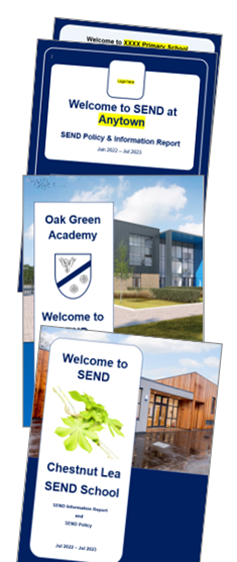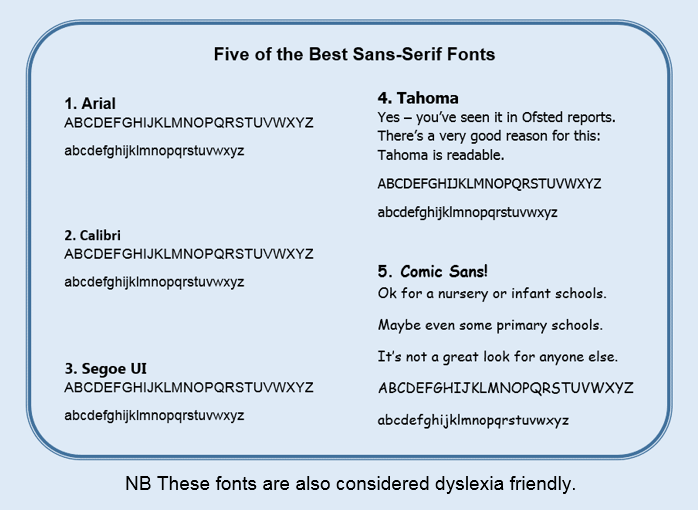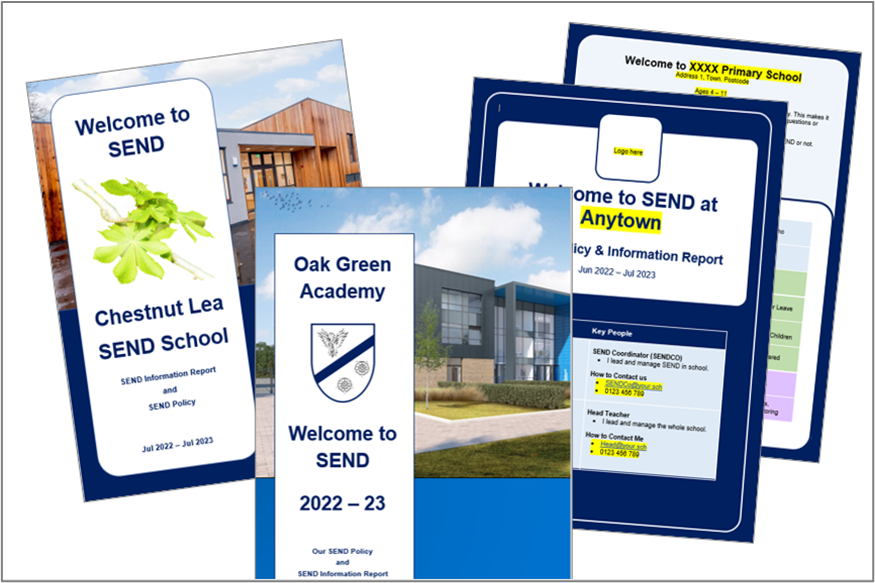Surprisingly, the first step to writing an outstanding SEND policy and SEND Information Report (SIR) is to decide which one you want to bin? The two documents duplicate each other. As the SEND Code of Practice mandates what must be in a SIR, it is best to keep that (and simply paste in any extra parts of your SEND policy that you want to keep). Your new document is your “Combined SEND Policy & Information Report.”
Whether that idea makes you excited or leaves you cold, read on…
Five steps to writing an outstanding SEND information report
- Combine your SEND Information Report and SEND Policy.
- Use pictures (to engage readers).
- Write in plain English (i.e. with a high level of readability).
- Use a clear font.
- Adopt good habits.
1. Why combine the SEND information report and SEND policy?
It benefits the people who need to read about SEND at your school (e.g. parents, staff). It pulls more of your SEND information into one place and, as the SENCo is now doing one document (rather than two), they can spend more time making it clear to read. This helps whether the reader is a new staff member, a parent who has literacy difficulties, or a parent who speaks English as an additional language.
Are we allowed to combine our SEND Information Report and SEND Policy?

Yes. The DfE say this is OK.
Separately, The Key, a well-trusted source, also asked the DfE. In an article How to review your SEN policy and information report (firewall), the Key report that:
- “The (SEND Information Report) can be included in your SEN policy, or presented as a separate document.”
- “The SEND policy does not have to be published as a separate stand-alone document.”
If you need a document for colleagues to prove that combining these documents is allowed, click to download “Is it OK?” (an A4 briefing). This download also includes the Ofsted position on the topic.
Some local authorities also have a document called ‘School’s Contribution to the Local Offer.’ This can also be combined into the same document so that parents and staff get all the information in one place.
Quick Tip: Use ‘SEND’
When you first use the term ‘Special Educational Needs or Disabilities’ add ‘(SEND)’ afterwards. After that, just use ‘SEND’ as it is quicker to read.
2. Use pictures in your SEND information report
Pictures break up text and give the reader a momentary rest. Whether it’s to show your school’s size (with a Google Earth image), or a simple fiddle toy, pictures can quickly convey useful information.
Also, pictures can signal your values – e.g. happy primary pupils playing Shark Top Trumps to signal that you know that social skills are important for autistic pupils. Smiling kids and great white sharks help to keep people reading.
It is hard to include images of SEND pupils. After all, the SEND status of a child is private. A quick-fix is to include this statement early in your document:
“Our photos of pupils are chosen regardless of whether they have SEND or not. This is inclusion.”
This then allows you to use photos of pupils from your school website or prospectus.
Alternatively, Pixabay offers thousands of free images, and you can use them without copyright worries. Their photos and illustrations, once added to your work, can quickly show the reader the topic of a page.

One excellent contributor is Peggy_Marco who provides simple bubble illustrations as well as photos and AI generated images.

If you need even more choice, then unsplash.com also offer copyright free pictures.
3. Make your SEND information report easily readable
The Flesch reading ease score is a way to find out if you have written in plain English. It is free to use and is even built into in Microsoft Word – you just have to click the right buttons to discover it.
The Flesch reading ease score is a mathematical formula that scores text out of 100, where 100 is easiest to read. Here’s a few examples of Flesch scores:
- 100 = Cat in the Hat
- 90+ = Fantastic Mr Fox
- 80+ = Boy by Roald Dahl
- 70+ = A Barack Obama speech
- 60+ = A typical BBC news website story
- 50 ish = Stephen Hawking’s Brief History of Time (first 2500 words)
- 30 ish = Academic paper on the transmissibility of new COVID variant
When writing anything for parents, aim for a score of over 60 because this is considered plain English.
You can check your score using tools that are already built into Microsoft Word. Google ‘How to use Flesch in Word.’
4. Use a Clear Font
Some font choices just slow down the reader – so choose a sans serif font, size 11 or 12, with 1.2 or 1.4 line spacing. This will help the reader digest the details that you want them to know.

Cursive Fonts in documents for parents
Cursive fonts (i.e. handwriting fonts) are more common in primary school policies. Avoid them in your SEND Information Report as they are harder to read and slow down you reader.

You can find more advice on writing for people who have visual impairments or dyslexia here.
5. Pick up good habits
Once you’ve been told what inclusive writing includes, some of it is incredibly easy to adopt for the rest of your life. Our four page guide to writing accessible SEND Policies / SIRs has information that will help you adopt new habits in your writing.
- How many words in a perfect sentence?
- When are there too many bullet points?
- Simple substitutes for your jargon
- White Space
- Tautology and saying things twice
- Active sentences
What do other SEND experts say?
Adam Boddison was the highly respected chief executive of NASEN. His view is that best practice goes beyond the basic requirements and ensures that the reports are as accessible and impactful as possible. He added that the requirements of the SEND Code of Practice are the minimum expectation. His book on SEND for school governors is excellent.
Andre Imich was a leading SEND expert at the DfE. He was the expert that other DfE SEND experts went to when they had a question. On SEND information reports, he asked “Do they convey a welcoming message? This is about celebrating the good work of a school. Do they do that enough?” (26:30 onwards). He added that most of the ones that he’d seen were just words and that parents do value photographs. He adds “What would be helpful would be colour and pictures and that there are ways of making them very attractive.”
Margaret Mulholland (ASCL SEND Lead) and Natalie Packer (SEND expert) also comment on this 2024 Schools Week article on the subject. The article also contains some stark comparisons between SEN information reports and a Stephen Hawking’s book on cosmology.
The next steps for your SEND information report
If SENCos follow the above advice, many more of families and staff will keep turning the page of their school’s SEND information report. They’ll know more and perform even better for pupils with SEND.
At worst, the world is a little bit fairer.
At best, pupils achieve even better outcomes in life.
This is a win-win.
This article gives you free advice on how to do even better. If after reading it, you want further support or training for your school, trust or LA, please get in touch. We can help you to develop an awesome SEND Information report – or SENCos can do it independently using the above advice.
You may also be interested in…
Image credits: 9000 Lives with photos of schools (title); Pixabay / 9000 Lives (body text).
Need help with SEND in your council, trust or school?
As well as SEND advice, we write inclusive and accessible policies for organisations like yours. Check out our feedback or get in touch.
Keep up to date with inclusion from 9000 Lives
- BlueSky @9000lives.bsky.social


